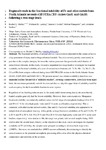Regional trends in the fractional solubility of Fe and other metals from North Atlantic aerosols (GEOTRACES cruises GA01 and GA03) following a two-stage leach
| dc.contributor.author | Shelley, RU | |
| dc.contributor.author | Landing, WM | |
| dc.contributor.author | Ussher, Simon | |
| dc.contributor.author | Planquette, H | |
| dc.contributor.author | Sarthou, G | |
| dc.date.accessioned | 2018-07-17T08:00:59Z | |
| dc.date.available | 2018-07-17T08:00:59Z | |
| dc.date.issued | 2018-04-18 | |
| dc.identifier.issn | 1726-4170 | |
| dc.identifier.issn | 1726-4189 | |
| dc.identifier.uri | http://hdl.handle.net/10026.1/11841 | |
| dc.description.abstract |
<jats:p>Abstract. The fractional solubility of aerosol-derived trace elements deposited to the ocean surface is a key parameter of many marine biogeochemical models. Despite this, it is currently poorly constrained, in part due to the complex interplay between the various processes that govern the solubilisation of aerosol trace elements. In this study, we used a sequential two-stage leach to investigate the regional variability in fractional solubility of a suite of aerosol trace elements (Al, Ti, Fe, Mn, Co, Ni, Cu, Zn, Cd, and Pb) from samples collected during three GEOTRACES cruises to the North Atlantic Ocean (GA01, GA03-2010, and GA03-2011). We present aerosol trace element solubility data from two sequential leaches that provide a solubility window, covering a conservative lower limit to an upper limit, the maximum potentially soluble fraction, and discuss why this upper limit of solubility could be used as a proxy for the bioavailable fraction in some regions. Regardless of the leaching solution used in this study (mild versus strong leach), the most heavily loaded samples generally had the lowest solubility. However, there were exceptions. Manganese fractional solubility was relatively uniform across the full range of atmospheric loading (32 ± 13 and 49 ± 13 % for ultra high-purity water and 25 % acetic acid leaches, respectively). This is consistent with other marine aerosol studies. Zinc and Cd fractional solubility also appeared to be independent of atmospheric loading. Although the average fractional solubilities of Zn and Cd (37 ± 28 and 55 ± 30 % for Zn and 39 ± 23 and 58 ± 26 % for Cd, for ultra high-purity water and 25 % acetic acid leaches, respectively) were similar to Mn, the range was greater, with several samples being 100 % soluble after the second leach. Finally, as the objective of this study was to investigate the regional variability in TE solubility, the samples were grouped according to air mass back trajectories (AMBTs). However, we conclude that AMBTs are not sufficiently discriminating to identify the aerosol sources or the potential effects of atmospheric processing on the physicochemical composition and solubility of the aerosols.</jats:p> | |
| dc.format.extent | 2271-2288 | |
| dc.language | en | |
| dc.language.iso | en | |
| dc.publisher | Copernicus GmbH | |
| dc.title | Regional trends in the fractional solubility of Fe and other metals from North Atlantic aerosols (GEOTRACES cruises GA01 and GA03) following a two-stage leach | |
| dc.type | journal-article | |
| dc.type | Journal Article | |
| plymouth.author-url | https://www.webofscience.com/api/gateway?GWVersion=2&SrcApp=PARTNER_APP&SrcAuth=LinksAMR&KeyUT=WOS:000430365200001&DestLinkType=FullRecord&DestApp=ALL_WOS&UsrCustomerID=11bb513d99f797142bcfeffcc58ea008 | |
| plymouth.issue | 8 | |
| plymouth.volume | 15 | |
| plymouth.publication-status | Published online | |
| plymouth.journal | Biogeosciences | |
| dc.identifier.doi | 10.5194/bg-15-2271-2018 | |
| plymouth.organisational-group | /Plymouth | |
| plymouth.organisational-group | /Plymouth/Faculty of Science and Engineering | |
| plymouth.organisational-group | /Plymouth/Faculty of Science and Engineering/School of Geography, Earth and Environmental Sciences | |
| plymouth.organisational-group | /Plymouth/REF 2021 Researchers by UoA | |
| plymouth.organisational-group | /Plymouth/REF 2021 Researchers by UoA/UoA07 Earth Systems and Environmental Sciences | |
| plymouth.organisational-group | /Plymouth/Research Groups | |
| plymouth.organisational-group | /Plymouth/Research Groups/BEACh | |
| plymouth.organisational-group | /Plymouth/Research Groups/Marine Institute | |
| plymouth.organisational-group | /Plymouth/Users by role | |
| plymouth.organisational-group | /Plymouth/Users by role/Academics | |
| plymouth.organisational-group | /Plymouth/Users by role/Researchers in ResearchFish submission | |
| dcterms.dateAccepted | 2018-03-22 | |
| dc.identifier.eissn | 1726-4189 | |
| dc.rights.embargoperiod | Not known | |
| rioxxterms.versionofrecord | 10.5194/bg-15-2271-2018 | |
| rioxxterms.licenseref.uri | http://www.rioxx.net/licenses/all-rights-reserved | |
| rioxxterms.licenseref.startdate | 2018-04-18 | |
| rioxxterms.type | Journal Article/Review |



